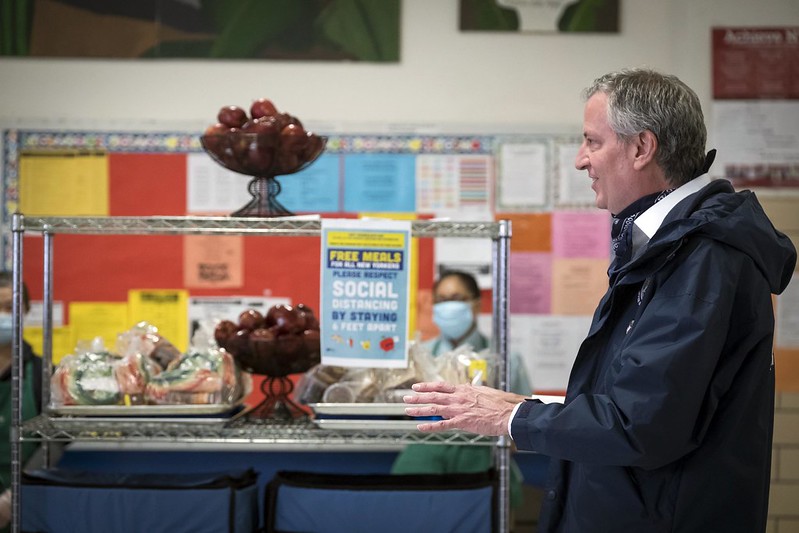
Mayor de Blasio at a school food site (photo: Ed Reed/Mayoral Photography Office)
In just a few weeks, more than 1 million New York City kids will head back to their school buildings — most of them for the first time since March 2020.
But the imminent return to a new normal in the classroom shouldn’t mean a return to the status quo when it comes to one of the biggest challenges our young people continue to face: hunger.
Before the pandemic, one in five New York City children struggled with hunger, meaning their families lacked the resources to consistently provide enough food. During the pandemic, that figure soared to one in four.
With so many kids at risk, the return to classrooms is both a challenge and an opportunity to do better. We can’t forget: the whole reason we’re climbing this mountain to reopen schools is to get our kids back on track and to be the best they can be.
But no child can reach their full potential in school while they’re facing hunger.
Many students are already facing a steep learning loss due to their time out of the classroom. Black, Latino and low-income students saw the steepest learning loss of all. As kids head back to school, the availability of free, nutritious meals will be critical to closing that gap and making sure all kids are fueled for success this school year.
So how do we achieve that?
First, we have to hold on to what works.
No Kid Hungry has spent years fighting for more alternative models for school meals that feed more kids — and we can’t let go of those wins now. Universal free school breakfast and lunch, breakfast in the classroom and “breakfast after the bell” all helped overcome barriers like social stigma and arcane bus schedules. Expanded vegan, Halal, and Kosher offerings ensured our diverse student body always had something nutritious to eat.
Now isn’t the time to walk away from what works. Let’s keep all of these programs running at full strength and adapt them as needed for social distancing and other safety measures.
Second, we need to make permanent the new programs that helped kids through the pandemic.
One of New York City’s biggest successes was the recognition that meals need to be readily available regardless of where kids are learning or where in the city a family lives. The hundreds of free meal hubs across the five boroughs where kids and families could pick up a meal at no cost all year-round were a game changer in the battle against hunger we’ve waged throughout this pandemic.
Even though New York City public schools are expected to return to full in-person learning this year, many families will still face inevitable closures or periods of quarantine as kids face exposure to the virus—and feeding those kids when they’re sent home has to be a priority. Continuing a flexible meal program — widely promoted in schools and communities – will help ensure all kids get nutritious food through the ups and downs this school year promises. And this same approach should continue to be a model for future summer meal programs as well.
Finally, we have to use this moment to break out of old thinking, and find new ways to reach more kids in need — because the hunger crisis caused by the pandemic will be with us for a long time.
One of the bright spots over the past year has been all the support from government: increased SNAP benefits for groceries, a larger Child Tax Credit, and Pandemic EBT. But we have yet to see a big push in New York City to enroll New Yorkers in programs they might be newly eligible for or to let them know what’s coming.
Here’s a simple solution — everyone who walks in the door of a public school, an ACS center, a homeless shelter, or any other office that provides social services should be automatically screened and enrolled in the most important food aid and child support programs. That will ensure every family has access to the hundreds—and in some cases thousands — of dollars now flowing through expanded federal aid that can help them put food on the table.
If we get this right, hundreds of thousands of kids across our city will have enough food both at school and at home, and we could see fewer kids facing hunger in our city than at any time on record.
But if we get this wrong, we’ll be failing to equip our children with one of the very most basic school supplies: the food they need to learn and reach their full potential.
The pre-pandemic status quo won’t be good enough. Let’s go above and beyond to make this the least hungry — and most successful — year in the history of New York City public schools.
***
Rachel Sabella is Director of No Kid Hungry New York. On Twitter @RachelS23 & @nokidhungry.
***
Have an op-ed idea or submission for Gotham Gazette? Email This email address is being protected from spambots. You need JavaScript enabled to view it.




